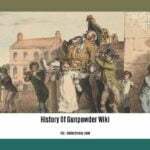Gettysburg’s Sacred Pause: Absolution Under Fire
Picture the scene: Gettysburg, July 2nd, 1863. The air is thick with the acrid smell of gunpowder, the roar of cannons a constant threat. Amidst this maelstrom of violence, a moment of unexpected tranquility emerges: Father William Corby, chaplain of the Irish Brigade, stands tall, offering absolution to his men. This poignant act, immortalized in Paul Wood’s painting “Absolution Under Fire,” transcended a simple religious ritual, becoming a testament to the human need for solace and connection in the face of death. The men of the Irish Brigade, predominantly Irish-American Catholic immigrants, knelt in prayer, finding strength in their shared faith as they braced themselves for the horrors of the Wheatfield. This wasn’t just about religious observance; it was about unity, courage, and the shared experience of facing mortality.
This “absolution of Gettysburg” wasn’t the Last Rites. Recognizing the extreme circumstances of war, the Catholic Church allows for general absolution when death is imminent. This communal act of grace offered a powerful moment of shared forgiveness, likely providing immeasurable comfort to the men far from home. It probably strengthened their resolve, reminding them of their shared humanity amidst the dehumanizing reality of war. [If you are intrigued by the occult, you might find the depiction of satan summoning his legions fascinating.]
The impact of this act resonates through history, captured in art, literature, and film, notably the 1993 movie “Gettysburg.” Its significance reaches beyond artistic representation, reflecting our fundamental need for hope and meaning in the face of adversity. While ongoing research continues to explore the event’s full impact, some historians suggest the absolution of Gettysburg played a crucial role in bolstering the Irish Brigade’s morale, contributing to their renowned bravery. Father Corby’s act of absolution wasn’t merely a moment in time; it’s an enduring symbol of spiritual resilience, reminding us of the power of human connection and faith amidst life’s darkest moments. [Alternatively, if you are a religious scholar, you might be interested in learning more about the tabernacle diagram.]
Corby’s Courage: Granting General Absolution
The second day of Gettysburg, July 2nd, 1863, found the Irish Brigade preparing to enter the Wheatfield, a place destined to become a scene of horrific carnage. Chaplain William Corby, understanding the gravity of the situation, climbed atop a boulder, making himself visible to the assembled men. With the battle looming and individual confessions impossible, he granted general absolution. This act, reserved for dire circumstances, served as an emergency measure for the soul.
Remarkably, Corby’s absolution extended beyond the Irish Brigade, encompassing all on the battlefield “susceptible of it,” regardless of allegiance. This potent gesture of compassion, recognizing the shared human need for forgiveness in the face of death, transcended the conflict itself. While historical accounts support the event’s occurrence, it’s important to acknowledge that the passage of time can sometimes subtly alter details. Nevertheless, the core of Father Corby’s act remains a powerful testament to spiritual solace in times of crisis.
Key Details of the General Absolution:
- Who: Father William Corby, Chaplain of the Irish Brigade.
- What: General absolution, an emergency Catholic rite for imminent danger. Offered to all susceptible to it, regardless of side.
- When: July 2, 1863, before the Irish Brigade entered the Wheatfield.
- Where: Cemetery Ridge, Gettysburg, Pennsylvania, atop a boulder (later the base of his statue).
- Why: Imminent battle, the impossibility of individual confessions.
- Outcome: 198 of the 530 men of the Irish Brigade became casualties in the Wheatfield that day.
Corby’s action raises compelling questions. How did soldiers on both sides receive this absolution? What did it mean to them in that moment? While definitive answers remain elusive, Corby’s act created a fleeting moment of unity amidst the brutal divisions of the Civil War, highlighting the universal yearning for spiritual comfort during wartime. A statue of Father Corby, dedicated in 1910, stands on the very boulder where he gave the absolution, the first Gettysburg monument not depicting a general.
People’s Statement (from source):
- “Let us hope that many thousands of souls, purified by hardships, fasting, prayer, and blood met a favorable sentence on the ever memorable battlefield of Gettysburg.”
- “That general absolution was intended for all – in quantum possum – not only for our brigade, but for all, North and South, who were susceptible of it and who were about to appear before their Judge.” (Father Corby)
Lee’s Defeat at Gettysburg: A Confluence of Factors
The Confederate defeat at Gettysburg, a pivotal moment in the Civil War, wasn’t the result of a single cause but a confluence of factors, each contributing to the disastrous outcome. Robert E. Lee’s invasion of the North, the Gettysburg Campaign, was a gamble predicated on a swift, decisive victory to demoralize the Union. This gamble, however, was based on flawed assumptions. Lee likely overestimated his army’s capabilities and underestimated the North’s resolve.
Flawed intelligence played a crucial role. Lacking accurate information about Union troop strength and movements, the Confederates stumbled into a major battle at Gettysburg, a location not part of their initial plans. The terrain itself proved disadvantageous. Gettysburg’s high ground and rocky hills, particularly Cemetery Ridge and Little Round Top, offered the Union a strong defensive position. Lee’s tactics, exemplified by Pickett’s Charge, proved ineffective against the entrenched Union lines, resulting in devastating casualties.
Internal disagreements within the Confederate command structure further complicated matters. Lee and General James Longstreet’s clashing views on strategy likely hindered coordination, adding to the confusion. Some historians believe that had Lee heeded Longstreet’s advice, the outcome might have been different.
The Gettysburg defeat, coupled with the fall of Vicksburg on the same day, July 3rd, 1863, dealt a crippling blow to the Confederacy. These losses marked a significant turning point in the war, shifting the momentum decisively in favor of the Union. While the exact weight of Gettysburg’s impact remains a subject of historical debate, its significance as a turning point is undeniable. Ongoing research may offer further insights, perhaps reshaping our understanding of this crucial battle.
The Grim Toll of Gettysburg: July 2nd’s Devastating Count
The Battle of Gettysburg raged for three bloody days, but July 2nd stands out as the most devastating. An estimated 20,000 soldiers became casualties on that single day, making it the 10th bloodiest battle of the entire Civil War. The sheer scale of the fighting underscores the brutality and suffering endured. However, determining the precise number of casualties for any single day, particularly July 2nd, is challenging due to the limitations of Civil War record-keeping. Incomplete records, missing soldiers, and the difficulty of accounting for those who died later from their wounds contribute to the complexity.
Despite these challenges, historical consensus points to July 2nd as the deadliest day at Gettysburg. This was the day of intense fighting at Little Round Top, Devil’s Den, Culp’s Hill, and the Peach Orchard, places where hand-to-hand combat and artillery fire decimated the ranks. The relentless fighting pushed both Union and Confederate forces to their limits.
Overall casualties for the three-day battle are estimated at around 51,000, encompassing killed, wounded, captured, and missing soldiers. This staggering figure highlights the battle’s devastating impact and its place as one of the bloodiest battles ever fought on American soil. Some historians suggest the actual figures could be even higher. Ongoing research continues to refine our understanding of the battle’s human cost.
While the Battle of Gettysburg’s military significance is undeniable, it’s crucial to remember that each casualty represents a life lost, a story cut short. The fields of Gettysburg serve as a somber reminder of the immense sacrifices made and the enduring importance of striving for peace.
- Georgia Platform: A Southern Strategy, 1850s - March 31, 2025
- How many weeks is 40 days: Quick Conversion Guide for Accurate Results - March 31, 2025
- How many feet is 300 meters? 984 Feet: Understand Length Conversions Easily - March 31, 2025
















